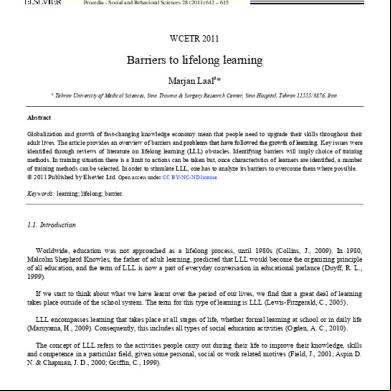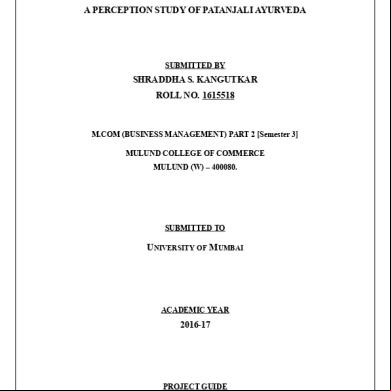Barriers To Entry 2e6770
This document was ed by and they confirmed that they have the permission to share it. If you are author or own the copyright of this book, please report to us by using this report form. Report 2z6p3t
Overview 5o1f4z
& View Barriers To Entry as PDF for free.
More details 6z3438
- Words: 731
- Pages: 3
Barriers to Entry Slowing industry growth makes entry problematic Threat of price retaliation Established players enjoy high brand equity High fixed costs and need for economies of scale High marketing costs and training costs for new stores or franchises Experience curve is important barrier but can be overcome by hiring of skills from market Facilitators of Entry The propensity of final s to switch to other foods makes entry at the local level relatively easy Capital intensity can be byed by franchising after first store (restaurant) On International markets, there may be little competition Major chains may encourage imitation by local chains better understanding local eating and consumption habits Opposition to western chains Initially, when the larger fast food chains first started to enter the Indian market, they bore the brunt of domestic opposition to foreign investment. Even when permission was secured to open an outlet, companies faced organised boycotts and threats of violence. In one celebrated instance, a KFC outlet was closed for breaching local hygiene regulations. As late as 1998, the Hindu extremists of the Vishwa Hindu Parishad (VHP) party campaigned against a new McDonald's outlet at Ville Parle in the Mumbai area, initially against its supposed use of beef (untrue - McDonald's bowed to Indian tastes and dietary practices by eschewing beef or pork in favour of using mutton). Later the VHP took a 'swadeshi' line, accusing the company of taking away local jobs. Ironically, local catering businesses did not this campaign - they saw it as threat to free trade
Domestic and International (BOTH) The leading domestic fast food chain - Nirulas - has meanwhile been playing on the fact that it has an extensive menu, insisting that other factors such as restaurant ambience and the whole eating experience also make a big difference to the customer. McDonald's, for instance, plays very heavily on the ambience factor, combining it with affordability. The international chains have also changed the concept of 'fresh food'. While Nirulas still operates with a centralised kitchen in Okhla, Delhi, supplying the food to all of its restaurants, others chains such as Dominos, Pizza Express, Pizza Hut and Pizza Corner, hand toss their pizzas after the order is placed. McDonald's has taken freshness to another plane all together, by establishing an extensive cold chain system. For example the lettuce used in burgers is exposed to the open air for less than six minutes, this makes sure it is as fresh as possible when it reaches the consumer. New entrant The largest domestic and internationally reputed dairy product manufacturer Gujarat Co-operative Milk Marketing Federation (GCMMF) has forayed into a fastfood chain business very recently. Their brand has been a huge success in India. The organisation now plans to set up around 2000 pizza parlours across India. The basic idea behind this is to establish consumption of 'mozzarella cheese'. Industry sources reveal that the next largest competitor to McDonald's worldwide, Burger King, is also eyeing India. Fastfood chains spreading fast (Number New entrant The largest domestic and internationally reputed dairy product manufacturer Gujarat Co-operative Milk Marketing Federation (GCMMF) has forayed into a fastfood chain business very recently. Their brand has been a huge success in India. The organisation now plans to set up around 2000 pizza parlours across India. The basic idea behind this is to establish consumption of 'mozzarella cheese'. Industry sources reveal that the next largest competitor to McDonald's worldwide, Burger King, is also eyeing India.
Fastfood chains spreading fast (Number of outlets) Brand 1996-97 1998-99 2000-2001 2005 ========================================================= Dominos 5 28 60 100 KFC 3 5 Discontinued -NAMcDonalds 3 15 30 80 Pizza Hut 2 10 15 30 TGI Friday 1 1 2 5 Pizza Express 1 1 2 4 Pizza Corner 4 25 50
The above table indicates the way the fastfood chains are spreading in India. McDonald's has plans to establish new outlets at the newly constructed highways and expressways in and around Delhi. The only unsuccessful story is that of KFC which did not blend well in the Indian market.
Challenges for international fast food entrants
Cold Chains in India are inadequate so sector entrants must have their own system.
Raw materials sourced from India sometimes may not match the international standards.
Continued competition from the culturally embedded 'artisan' sector.
A large majority of Indian consumer still prefer traditional style and ethnic cuisine in restaurants
Domestic and International (BOTH) The leading domestic fast food chain - Nirulas - has meanwhile been playing on the fact that it has an extensive menu, insisting that other factors such as restaurant ambience and the whole eating experience also make a big difference to the customer. McDonald's, for instance, plays very heavily on the ambience factor, combining it with affordability. The international chains have also changed the concept of 'fresh food'. While Nirulas still operates with a centralised kitchen in Okhla, Delhi, supplying the food to all of its restaurants, others chains such as Dominos, Pizza Express, Pizza Hut and Pizza Corner, hand toss their pizzas after the order is placed. McDonald's has taken freshness to another plane all together, by establishing an extensive cold chain system. For example the lettuce used in burgers is exposed to the open air for less than six minutes, this makes sure it is as fresh as possible when it reaches the consumer. New entrant The largest domestic and internationally reputed dairy product manufacturer Gujarat Co-operative Milk Marketing Federation (GCMMF) has forayed into a fastfood chain business very recently. Their brand has been a huge success in India. The organisation now plans to set up around 2000 pizza parlours across India. The basic idea behind this is to establish consumption of 'mozzarella cheese'. Industry sources reveal that the next largest competitor to McDonald's worldwide, Burger King, is also eyeing India. Fastfood chains spreading fast (Number New entrant The largest domestic and internationally reputed dairy product manufacturer Gujarat Co-operative Milk Marketing Federation (GCMMF) has forayed into a fastfood chain business very recently. Their brand has been a huge success in India. The organisation now plans to set up around 2000 pizza parlours across India. The basic idea behind this is to establish consumption of 'mozzarella cheese'. Industry sources reveal that the next largest competitor to McDonald's worldwide, Burger King, is also eyeing India.
Fastfood chains spreading fast (Number of outlets) Brand 1996-97 1998-99 2000-2001 2005 ========================================================= Dominos 5 28 60 100 KFC 3 5 Discontinued -NAMcDonalds 3 15 30 80 Pizza Hut 2 10 15 30 TGI Friday 1 1 2 5 Pizza Express 1 1 2 4 Pizza Corner 4 25 50
The above table indicates the way the fastfood chains are spreading in India. McDonald's has plans to establish new outlets at the newly constructed highways and expressways in and around Delhi. The only unsuccessful story is that of KFC which did not blend well in the Indian market.
Challenges for international fast food entrants
Cold Chains in India are inadequate so sector entrants must have their own system.
Raw materials sourced from India sometimes may not match the international standards.
Continued competition from the culturally embedded 'artisan' sector.
A large majority of Indian consumer still prefer traditional style and ethnic cuisine in restaurants










